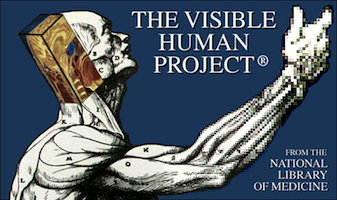Visible Human Female
Jump to:
From Time Machine
The Visible Human Project is an effort by the U.S. National Library of Medicine to create high-resolution, male and female human anatomical datasets. The datasets were created by sectioning frozen male and female cadavers at regular intervals and photographing and digitizing each section. The female dataset was sectioned at .33 mm intervals.
Vein to exit
The superior sagittal sinus is a longitudinally oriented vein, running front to back, inside the skull. The superior sagittal sinus, as it travels in the midline, becomes progressively more vertically oriented as it terminates in a "T" shaped intersection, giving off the right and left transverse venous sinuses. We follow one of the two horizontally oriented transverse sinuses to the "S" shaped sigmoid venous sinus, which then empties into the jugular vein. The jugular vein collects progressively greater amounts of venous tributaries and drainage until it empties into the largest vein in the body, the vena cava. The superior vena cava, that portion above the heart, is vertically aligned with the inferior vena cava which is below the heart, and which we enter after dropping through the right atrium of the heart. As we move through the inferior vena cava we see joining venous tributaries providing the venous drainage from the gastrointestinal tract and liver, we continue to move inferiorly through the right common iliac vein. As we move further inferiorly, we eventually arrive in the right superficial femoral vein, at which point an adjoining disruption in the skin surface is shown indicating the dissection site for exposure of the femoral artery and vein, which permitted perfusion preparation of the visible human subject.
Take a
tour from vein to exit.#tour=EcAoGxCsvxjjG4m-lyDvIThe%20superior%20sagittal%20sinus%20is%20a%20longitudinally%20oriented%20vein%2C%20running%20front%20to%20back%2C%20inside%20the%20skull%2E__B6HxCsvxjjG4m-lyDvIThe%20superior%20sagittal%20sinus%20is%20a%20longitudinally%20oriented%20vein%2C%20running%20front%20to%20back%2C%20inside%20the%20skull%2E__B6HnEurzmhGvvyn_CvIThe%20superior%20sagittal%20sinus%20becomes%20more%20vertically%20oriented%20as%20it%20terminates%20in%20a%20%22T%22%20shaped%20intersection%2E__B2EtK5gor0Fs36zzCvIThe%20superior%20sagittal%20sinus%20becomes%20more%20vertically%20oriented%20as%20it%20terminates%20in%20a%20%22T%22%20shaped%20intersection%2E__B2E_K9l7snFtip1gDvIWe%20follow%20one%20of%20the%20two%20horizontally%20oriented%20transverse%20sinuses%20to%20the%20%22S%22%20shaped%20sigmoid%20venous%20sinus%2C%20__B2E1M23uxgFv8j18DvIWe%20follow%20one%20of%20the%20two%20horizontally%20oriented%20transverse%20sinuses%20to%20the%20%22S%22%20shaped%20sigmoid%20venous%20sinus%2C%20__B6H5N90z9mFuv05lEvIwhich%20then%20empties%20into%20the%20jugular%20vein%2E__B6H3R90z9mFuv05lEvIThe%20jugular%20vein%20collects%20progressively%20greater%20amounts%20of%20venous%20tributaries%20and%20drainage__B6HqZ5--1rF-4i1iEqJuntil%20it%20empties%20into%20the%20largest%20vein%20in%20the%20body%2C%20the%20vena%20cava%2E__B6HseyssjyF-_gr1DqJThe%20superior%20vena%20cava%20above%20the%20heart%20is%20vertically%20aligned%20with%20the%20inferior%20vena%20cava%20below%20the%20heart%2C__B6HigBgn3k2FogjpzDqJThe%20superior%20vena%20cava%20above%20the%20heart%20is%20vertically%20aligned%20with%20the%20inferior%20vena%20cava%20below%20the%20heart%2C__B6HgkBuuh41Fx0rvvDqJand%20which%20we%20enter%20after%20dropping%20through%20the%20right%20atrium%20of%20the%20heart%2E__B6H8rB5t-hiGvh93gDjKAs%20we%20move%20through%20the%20inferior%20vena%20cava%20we%20see%20joining%20venous%20tributaries__B6HytB6pj45F72o27CjKAs%20we%20move%20through%20the%20inferior%20vena%20cava%20we%20see%20joining%20venous%20tributaries__B6H80Blm7z5Ftop1lDjKproviding%20the%20venous%20drainage%20from%20the%20gastrointestinal%20tract%20and%20liver%2E__B6Hi7Bxg937FokrwsDnLproviding%20the%20venous%20drainage%20from%20the%20gastrointestinal%20tract%20and%20liver%2E__B6H7_Bxk-09FovptsDzLproviding%20the%20venous%20drainage%20from%20the%20gastrointestinal%20tract%20and%20liver%2E__B6HxhCxshq4F4nv_pDzLWe%20continue%20to%20move%20inferiorly%20through%20the%20right%20common%20iliac%20vein%2E__B6H4lCh7vvpF45_9qDzLWe%20continue%20to%20move%20inferiorly%20through%20the%20right%20common%20iliac%20vein%2E__B6HunC8qtlnF6g1nwDyJWe%20continue%20to%20move%20inferiorly%20through%20the%20right%20common%20iliac%20vein%2E__B6H2pCyyyigFws6u6D7GWe%20continue%20to%20move%20inferiorly%20through%20the%20right%20common%20iliac%20vein%2E__B6HvuClwk-yEnog8uEtEWe%20continue%20to%20move%20inferiorly%20through%20the%20right%20common%20iliac%20vein%2E__B6HozCh_96sEu21glEtEAs%20we%20move%20further%20inferiorly%2C%20we%20eventually%20arrive%20in%20the%20right%20superficial%20femoral%20vein%2E__B6H43C0y5lyEzlt2yEqHAs%20we%20move%20further%20inferiorly%2C%20we%20eventually%20arrive%20in%20the%20right%20superficial%20femoral%20vein%2E__B6Hu5C0y5lyEgtptsEqHAn%20adjoining%20disruption%20in%20the%20skin%20surface%20indicates%20the%20dissection%20site%20for%20exposure%20of%20the%20femoral%20artery%20and%20vein%2E__AsJl8Cvjpt3Enx-h3D-EAn%20adjoining%20disruption%20in%20the%20skin%20surface%20indicates%20the%20dissection%20site%20for%20exposure%20of%20the%20femoral%20artery%20and%20vein%2E__A0P87Cvjpt3Enx-h3D-Ewhich%20permitted%20perfusion%20preparation%20of%20the%20visible%20human%20subject%2E__BAg9CgggqjGw82-xEA__From%20Vein%20to%20Exit_B
Dropping down the atherosclerotic aorta
The common carotid artery is the initial departure point for our trip through the largest artery in the body; the aorta. The irregular corrugated yellow material found lining the carotid artery and then aorta is atherosclerosis, which is dense and heaped-up in places. In this particular middle-aged female subject, the amount of atherosclerosis is notable. As we move inferiorly through the aptly named aortic arch, we continue inferiorly in the posterior left portion of the chest, adjacent to the heart. The descending aorta is oriented vertically parallel to the axis of the body, and can be seen dividing in to the multiple arteries feeding oxygenated blood to the organs and tissues in an elaborate and arborizing manner. In the pelvis, the aorta divides into the common iliac arteries; we follow the right iliac artery to the common and superficial femoral arteries, which adjoin a disruption site in the skin surface, indicating the dissection site for exposure of the femoral artery and vein which permitted perfusion preparation of the visible human subject.
Take a
tour dropping down the atherosclerotic aorta.#tour=ENAwMyS7076qF7quknE_CThe%20common%20carotid%20artery%20is%20the%20initial%20departure%20point%20for%20our%20trip%20through%20the%20largest%20artery%20in%20the%20body%2C%20the%20aorta%2E__AsJyS7076qF7quknEzK__A4S0X3lr6vFyvni_DzKThe%20irregular%20corrugated%20yellow%20material%20found%20lining%20the%20carotid%20artery%20and%20then%20aorta%20is%20atherosclerosis%2E__AoG2cn5u-3F8y1-4DzKAs%20we%20move%20inferiorly%20through%20the%20aptly%20named%20aortic%20arch%2C__AkDse02xrlGtk_10DzKwe%20continue%20inferiorly%20in%20the%20posterior%20left%20portion%20of%20the%20chest%2C%20adjacent%20to%20the%20heart%2E__AkDnfniwz0G6u_mnDzKwe%20continue%20inferiorly%20in%20the%20posterior%20left%20portion%20of%20the%20chest%2C%20adjacent%20to%20the%20heart%2E__A4SmhBpn9u4G5mqp0CzKThe%20descending%20aorta%20is%20oriented%20vertically%20parallel%20to%20the%20axis%20of%20the%20body%2C__A4rBhrBrwpw9G8t89sCzKand%20can%20be%20seen%20dividing%20in%20to%20the%20multiple%20arteries%2E__A6H7_Bx6uztGlr0-xDzKIn%20the%20pelvis%2C%20the%20aorta%20divides%20into%20the%20common%20iliac%20arteries%2E__A4SikCquhgwF4y8uvDzKWe%20follow%20the%20right%20iliac%20artery%20to%20the%20common%20and%20superficial%20femoral%20arteries%2C__AgZ8vC20r5wEr6yiuEzKindicating%20the%20dissection%20site%20for%20exposure%20of%20the%20femoral%20artery%20and%20vein__AwM38Cz_434Ei9xz5DzKwhich%20permitted%20perfusion%20preparation%20of%20the%20visible%20human%20subject%2E__BA38Csqk28Fys-1rD6C__The%20Atherosclerotic%20Aorta_B
Rostral to caudal: Brain to base of spine
The anterior commissure is one of the major connecting pathways between the right and left hemispheres of the brain, and is believed to confer the ability to multitask and juggle complex efforts, also known as "executive function". As we travel inferiorly, we encounter the brainstem, which controls almost all of our most basic functions. The brainstem is continuous with the cervical spinal cord in the neck, which travels inferiorly through the spinal canal, lying within and protected by the bony tunnel of the spinal canal, bathed and supported in a pool of cerebrospinal fluid. The thoracic spinal cord continues through the thoracic spinal canal, and terminates as a literal bundle of nerves slightly below the lowest rib, and the gradually diverging and disaggregated nerves travel through the lumbar spinal canal of the lower back, exiting individual spinal foramina to arrive at their final destinations in serving sensing functions, and serving motor functions when innervating our various muscles and organs.
Take a
tour from rostral to caudal.#tour=EKAgZpJps53_Fsyh5sElDThe%20anterior%20commissure%2C%20a%20major%20connecting%20pathway%20between%20the%20two%20hemispheres%20of%20the%20brain%2C%20aids%20in%20multitasking%2E__A4SpJxm6-hG4238jE3JAs%20we%20travel%20inferiorly%2C%20we%20encounter%20the%20brainstem%2C%20which%20controls%20almost%20all%20of%20our%20most%20basic%20functions%2E__AwMtTm2m5_F-k7k4D3J__A0Pla8-3mkGt4j56C3JThe%20brainstem%20is%20continuous%20with%20the%20spinal%20cord%20in%20the%20neck%2C%20which%20travels%20through%20and%20protected%20by%20the%20spinal%20canal%2E__AwMselvijmG39olpC3JThe%20thoracic%20spinal%20cord%20continues%20through%20the%20thoracic%20spinal%20canal%2C__AyaklBr3wqnG-r129B3Jand%20terminates%20as%20a%20literal%20bundle%20of%20nerves%20slightly%20below%20the%20lowest%20rib%2E__AgZryBtnu4nGg8yk-B3JThe%20gradually%20diverging%20and%20disaggregated%20nerves%20travel%20through%20the%20lumbar%20spinal%20canal%20of%20the%20lower%20back%2C__AoGxhCt_j2nGm-rrsC3Jexiting%20individual%20spinal%20foramina%20to%20arrive%20at%20their%20final%20destinations%20in%20serving%20sensing%20functions%2C__A0P9kCov01mG_k6pkC3Jand%20serving%20motor%20functions%20when%20innervating%20our%20various%20muscles%20and%20organs%2E__BA9kCvpwxiGuhnp9DpB__From%20Rostral%20to%20Caudal_B
Annotations and tours by Alexander Norbash, Professor and Chair of Radiology, Boston University School of Medicine
| The Visible Human Project imagery presented here is provided courtesy of the National Library of Medicine under a license agreement to Carnegie Mellon University. The National Library of Medicine retains ownership and copyright. |
 |
{"id":"vhf-crf28-g10-bf0-l","dataset":1,"host":"000","has_layers":false,"repeat":false,"show_timewarp_composer":true,"forceMP4":false,"use_tm1":true}






